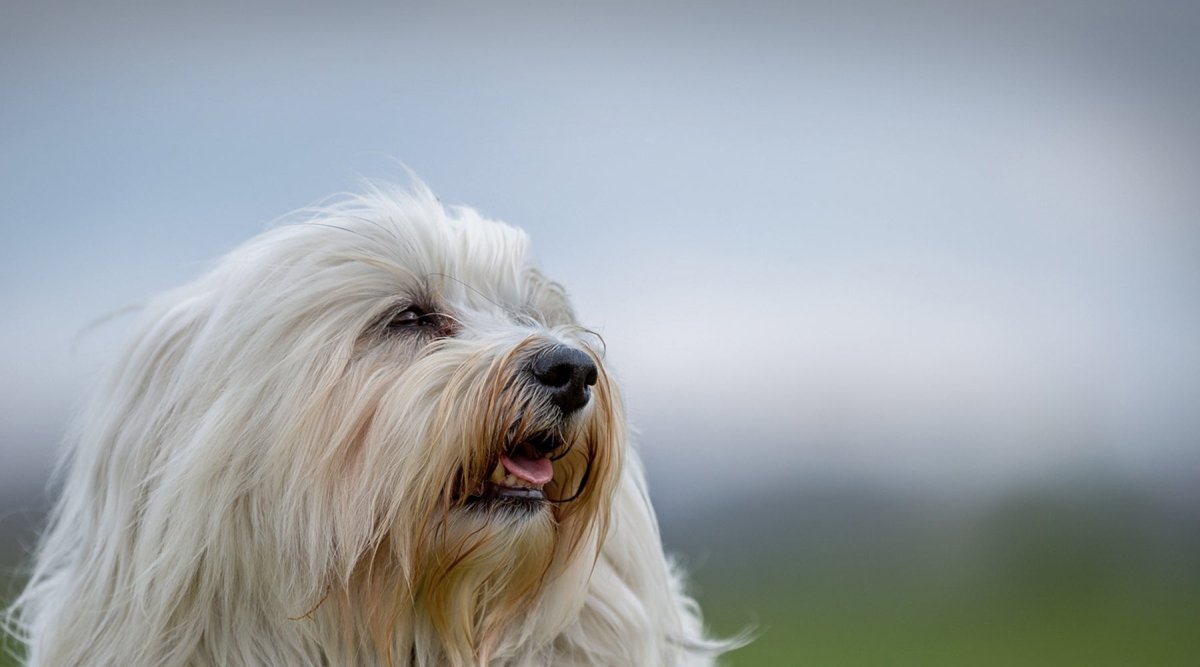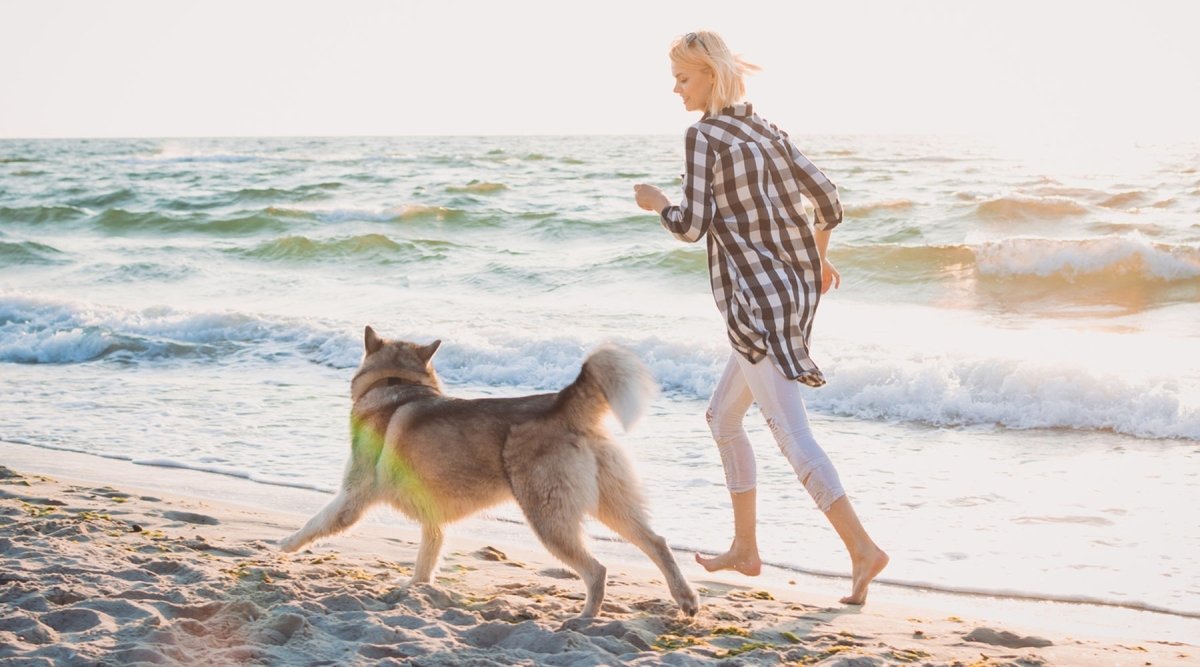The Chinese Crested Dog - a breed that is not loved by everyone. Some think it's great, others question whether it's a dog at all. In this breed portrait, we introduce you to the Chinese Crested Dog, its character and show you whether this dog breed is right for you.
What does a Chinese Crested Dog look like?
The Chinese Crested Dog is definitely a dog that immediately catches the eye. As the name crested dog suggests, these dogs are predominantly naked and without fur. The Chinese Crested Dog only has a long coat in a few places. The mop of hair is partly covered with long head hair and the lower legs are also hairy, making it look as if the dog is wearing socks. The straight, upwardly protruding tail is also covered with fur. Lovers of this breed describe the dog as graceful and noble.
The Chinese Crested Dog has a slender neck and large erect ears with long fringes of hair. The coat of this breed is mostly white-grey with some black highlights. The skin can be spotted and is very oily, as it acts as a coat to protect the four-legged friend from the weather. The skin color is also usually gray, with pigmentation decreasing in winter and increasing again in spring.
The Chinese Crested Dog reaches a height at the withers of between 28 - 33 cm, has a supple, long body and weighs between 4 - 6 kg on average. The Chinese Crested Dog is divided into two types:
- Deer type - racy and fine-boned
- Cobby type - stocky, with a stronger body and bone structure
However, there are also hairy puppies in crested dog litters. This can occur even if both parents are naked. The hairy dogs of this breed are called Powder Puff. The soft coat covers the entire body of the animals and consists of both undercoat and normal top coat.
Chinese naked dog - character and traits
But how does a Chinese Hairless Dog behave? The character and temperament of this breed can be very distinctive. Despite its small size and dainty appearance, the Chinese Crested Dog is a robust, lively little fellow. He has a cheerful disposition and is very attached to his owner, making him a truly loyal soul. However, this can also manifest itself in him becoming very affectionate, which can be exhausting at times.
His character also makes him very sensitive and he needs a certain amount of empathy from his owner. Regular educational games promote his development and strengthen the animal-human relationship. As he is very willing to learn, he can quickly implement what is expected of him.
Chinese Hairless Dog - Character that describes the nature of this breed:
- Smart
- Playful
- Alert
- Very lively
- Agile
However, they are also said to be very shy of strangers and sometimes even overly fearful.
The breed can look back on thousands of years of history. Although there is no clear evidence, it is assumed from the name that naked dogs originated in China. They probably date back to the Han Dynasty family and were bred both as hunting dogs and to protect the estate and its precious treasures.
However, there are also indications that the naked dogs originated in South and Central America. In Peru, these alert dogs have a long tradition and the breed is known as the Viringo or Peruvian Hairless Dog.
Frequent hereditary diseases and restrictions
Breeding this breed is very controversial. Misbreeding in Chinese crested dogs can lead to an open gap in the skull bone (fontanel), in some cases this can grow over time. As a rule, the dogs are able to survive, but care must be taken to ensure that this extremely sensitive area is well protected. A lot of romping around, especially with other dogs of the same species, should be prevented.
Other diseases affect the eyes of small four-legged friends. Corneal inflammation, lens dislocation, glaucoma and dry eyes are among the most common eye diseases. However, they are not only found in this breed, but in many other small dog breeds.
Skin problems also occur more frequently in these animals than in fur-covered animals. This is because the coat protects the dog from environmental influences, knocks and injuries. In this breed, the skin is unprotected, which is why injuries occur frequently.
In a study on hairless dogs, researchers from various universities and institutes in Switzerland, Finland, the USA and Sweden have discovered a gene mutation that is responsible for the development of the outer layer of tissue. This gene is thought to be responsible for the lack of hair and, in some cases, teeth in hairless dogs.
Unfortunately, Chinese crested dogs do not live as long as other small dogs. The average life expectancy for dogs of this size is 14-16 years, whereas the Chinese Crested Dog only has a lifespan of around 10 years.
Chinese Crested Dog - care and keeping
Due to its small size, the Chinese Crested Dog can be kept both in an apartment and in a house with a garden. It particularly likes to be where its owner is.
Due to the naked dog's lack of hair, it should be protected from excessive sunlight in summer. Otherwise there is a high risk of sunburn. Sun cream for dogs without synthetic additives should be part of their standard care routine as soon as warm sunny days set in. A skin care cream especially for dogs is ideal for regular skin care. This should consist of purely natural ingredients and gently care for your little four-legged friend's skin.
A Chinese Hairless Dog also needs to be protected from the cold and wet in cold temperatures. A water-repellent winter coat is ideal for this breed. It keeps the little rascal warm and replaces the natural protection of a coat.
After walks through woods and meadows, the skin and the few hairy areas should be checked, especially during the tick season. The use of spot-on for dogs against ticks would be possible, but less suitable for naked dogs due to their sensitive skin. Tick repellents for dogs for external use or tick capsules for internal use should be used on the Chinese Crested Dog.
Grooming is also limited for this breed. Nevertheless, it is particularly important for the Chinese Crested Dog, even if it is much quicker to manage. The short coat must be trimmed regularly, especially around the eyes. Otherwise, it will hinder your dog's vision and may irritate the eyes.
You can use coconut oil for dogs to care for their skin. This supports your four-legged friend's energy metabolism and can also be applied to the skin. This makes it supple and soft.
The Chinese Crested puppies of the Powder Puff have significantly more fur. You can find out how to care for your dog's coat properly in our magazine article: Dog coat care - important for health and well-being.
Chinese crested dog food - what you need to look out for
A Chinese Crested Dog is very different in appearance to other dogs, which is why food should play a very special role for Chinese Crested Dogs. For this breed of dog, it is important to take a closer look at the composition of the nutrients. The right amount of vitamins and minerals is important for the Chinese Crested Dog breed. Food, conventional or BARF, is usually the main source of these nutrients.
Due to the lack of fur, the skin of the Chinese Crested Dog must remain vital and strong. A dog food with essential omega-3 fatty acids is therefore essential. If the food does not provide these important fats, salmon oil for dogs should be used to balance the nutrients. Salmon oil can easily be mixed into your dog's favorite food. In this way, a Chinese Crested dog gets food that it likes and the supply of the important omega-3 fatty acids is ensured.
However, healthy fats are not enough. But what does a Chinese Crested Dog need? Food that not only tastes good and provides it with sufficient omega-3 fatty acids, but also a type of meat that is not too lean. Beef dog food, lamb dog food or buffalo dog food contain a lot of crude protein and crude fat. These types of meat ensure that your Chinese Crested Dog does not become too thin.
If a Chinese crested dog is fed food that does not meet its nutritional requirements, it can become ill. Allergies, damage to the skin and coat and a weakened immune system can be the result.
A healthy and species-appropriate diet with a high meat content is recommended for all dog breeds, including the Chinese Crested Dog. Food and treats should be suitable for small dog mouths. Due to the lack of hair, the Chinese Crested Dog burns food more quickly to generate heat. For this reason, it may require a slightly larger food ration than other dog breeds of the same size. Looking at the dog's waist helps to find the right size.
Is a Chinese Crested dog right for me?
These dogs are undemanding and easy to please. They are therefore ideal as a beginner's dog. However, you should have enough time for your four-legged friend and spend a lot of time with them, as they don't like loneliness. If you have a preference for dog sports, you can also do this with the Chinese Crested Dog, but you should avoid long jogging laps.
As the Chinese Crested Dog is easy to train, it also feels very comfortable with families. It is very playful and not very aggressive, which is why it goes well with children and quickly forms an intense bond with its fellow human beings. Due to its small size, it is also suitable for smaller children.
Singles, couples or older people will also be happy with this little rascal. However, he does not like globetrotters who regularly leave him alone or put him up with friends or in kennels. If a longer journey is on the cards, the Chinese Crested Dog can be taken along in the passenger area of an airplane due to its size and weight.
Conclusion
Although this dog breed is not very popular and the breeding of the Chinese Crested Dog is repeatedly questioned, this little rascal is a lovable dog with many great character traits. It is suitable for families with dogs as well as single households. Due to its lack of coat, its skin must be protected and cared for so that weather influences do not restrict it too much. If you want to buy a Chinese Crested Dog, you are getting a bright, loyal companion who is eager to learn.



